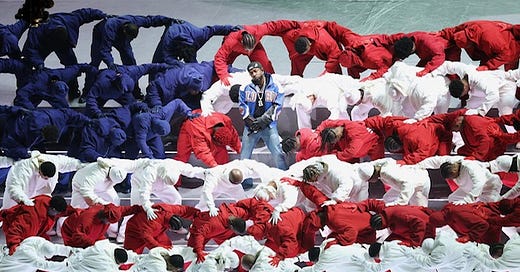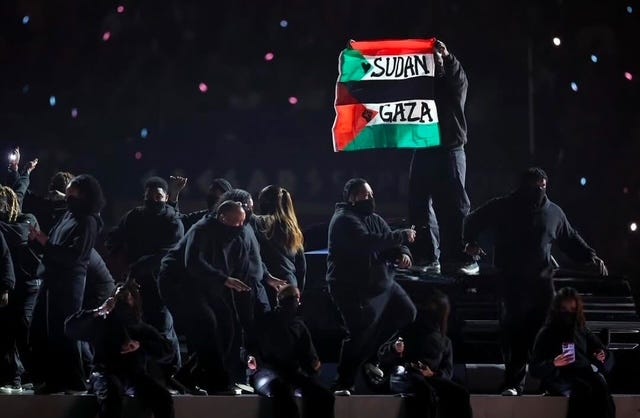Kendrick at the Super Bowl: a conversation-starter
Reflections on K.Dot, SZA, Uncle Sam, and that halftime show
Kendrick gave us the black history month concert we needed. The Juneteenth show that he put on should have prepared me, prepared us for what we saw, but the scale of artistic ambition — and its largely successful execution — was bigger and better than I expected. The combination of SZA, Uncle Sam(uel) Jackson, Kendrick, and excellent choreography brought us a halftime show that redefined the parameters of belonging of black people, black music, and black futures.
In stream of consciousness form, here’s my points of particular appreciation for yesterday’s halftime show, below:
TDE out here eating: TDE, the label that Kendrick, SZA, and so many others, Doechii comes to mind here as well, is out here pacesetting for hip-hop culture. Between the Grammy victories, the Superbowl show, the forthcoming concerts, the Late Show and Tiny Desk impressions, they are putting on for the culture like they want to help initiate a renaissance in black popular music. I ain’t mad at all, not one bit.
From Juneteenth to the Superbowl: The halftime show yesterday felt like part two of the Juneteenth pop out. The main similarities are that Kendrick brought all the cousins out to join him at both events and that, of course, Not Like Us was the centerpiece and culminating song of the affair. There is more than a bit of irony for Kendrick’s wonderful art to be embedded on decidedly unwonderful platforms — Amazon sent forth the Juneteenth concert, Fox News hosted the Superbowl. That isn’t a passing remark, but rather an acknowledgement that even our best popular art comes to us beautiful, yet sullied, provocative yet enmeshed in the systems that do not love us, nor their workers. In my mind, that contradiction is not only Kendrick’s responsibility to resolve - that resolving onus belongs to us, the audience, the people, as well.
The revolution quote: Kendrick opens with a Gil-Scot Heron influenced quote, along the lines of: “the Revolution will be televised. You picked the wrong time. But the wrong guy”. A little shopworn, but nonetheless a nice homage to the black arts tradition of spoken word poetry, and in particular a phrase which has become a canvass against which to measure one’s social critique and vision of the world
The Americana: Perhaps the most notable visual choice was the color scheme of the red, white, and blue dancers, coupled with the same palette on Kendrick’s jacket and that of Uncle Sammy, Samuel Jackson. Witnessing a cultural reclamation of the country — as an act of defiance and artistic expression — at a time when the MAGA project of blowing up democratic institutions is underway, felt moving. Satisfying. But also: there’s this sense of, how we go, again.
The barbershop quartet motif, but make it hip-hop: Kendrick rapping in front of the crew, complete with the gold grills, singing in a kind of doo-wop fashion was a nice touch. A further reclaiming of a tradition that actually has hip-hop roots, such as Lauryn Hill’s classic song from Miseducation, or the opening press run and styles of Boyz II Men in their MotownPhilly days.
Sharing the Spotlight: I love to see Kendrick and SZA perform. They have chemistry. They’ve made history together. They’re obviously setting up the next thing, as they prepare to go on tour together. Be that as it may, All the Stars and Luther was, in my estimation, the musical highpoint of the halftime show.
Mustard!!!! Kendrick and DJ Mustard have a bromance for the ages. That moment where turn the TV off came off, signaling the end of the performance, and perhaps the end of a historic run for Kendrick was a chef’s kiss.
Cite black women, cite Beyonce: Beyonce’s halftime retrieval of both country music and Americana imagery at the Christmas Day game - less than two months ago — established the context for audiences to hear, and for artists to present, a reinterpretation of who America is for, what the country is all about. That reinterpretation need not be presented as inherently revolutionary in a political sense to be valuable. It is, however, a culturally and moral significant assertion of membership, belonging, and artistic presence, for to black folk, and then by extension to audiences beyond our community. That’s a needed lane, and a powerful one on its own terms as well. The point isn’t to develop an uncritical relationship to hope or to America. Rather, the goal is to use the tools at our hand, the law, the cultural symbols, the traditions of democracy to make of this land something livable. Something workable.
40 Acres and a Mule: Kendrick gave us an oblique but needed reference to reparations when he noted, “40 acres and a mule. It’s deeper than the music”. I’ll take it. I’ll take it!
Free Sudan, Free Gaza: The references to free Sudan and free Gaza, while not set in place by Kendrick, were arguably set in motion, to a degree, by the kind of collaborative performance that he set in place. It was a needed message to share in any event, and is forever embedded in the performance itself. There’s tension between the Uncle Sam character and the Free Sudan, Free Gaza flag, a tension that black politics hasn’t yet resolved, a tension that American politics, under its current administration is arguably causing and exacerbating.
So much to enjoy in the performance, so much to rewatch. But also: a masterclass in approaching the format differently. What Kendrick saw to do was fundamentally different from, say, a Michael Jackson or Usher performance. And that’s not necessarily a knock on them, but rather a note, for all the creatives, that one can, that we must, present our art on terms that we think express our craft, and help our people live. Kendrick did that — and then some.



